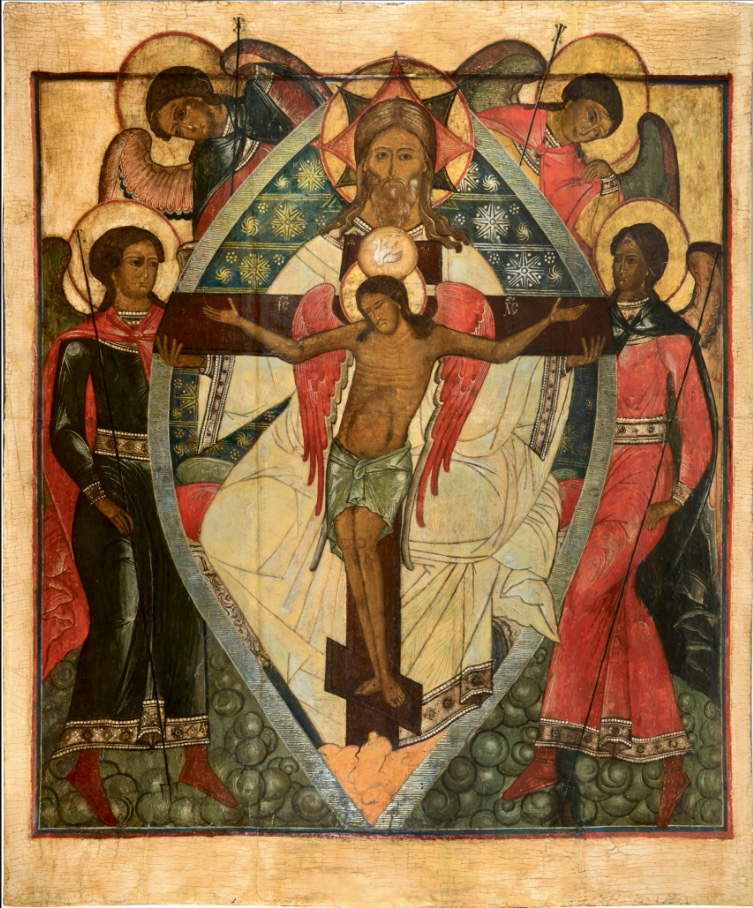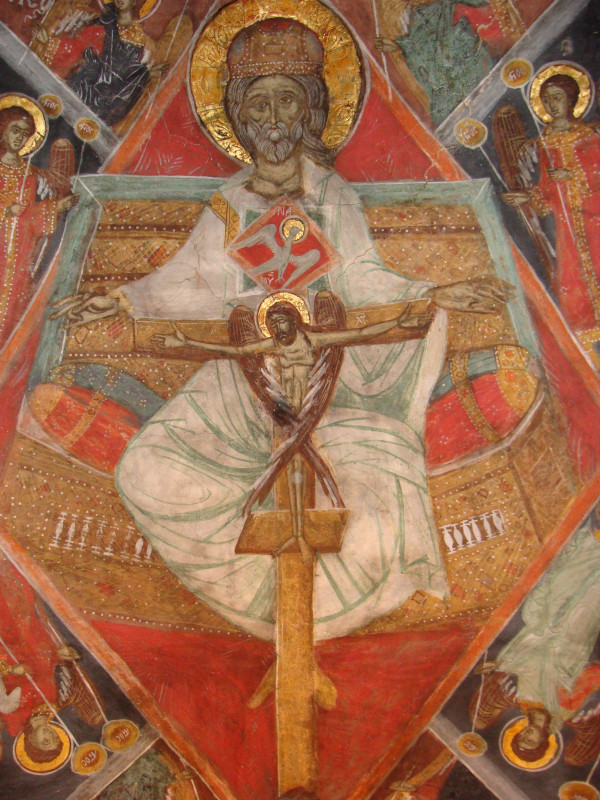In the Name of the Father, and of the Son, and of the Holy Spirit.
On this Forgiveness Sunday when we commemorate the casting out of Adam and Eve from Eden, we reflect on the fall and exile of the first-father and the first mother through their disobedience and rebellion against God, yet we do so on the threshold of the wonderful journey that leads us from this annual commemoration of the sorrow of banishment to the wonder of Pascha: the great sign and celebration of our salvation, and of our reconciliation with God through the Saviour’s life-giving passion and third-day resurrection.
We embark on this penitential-journey with the foreknowledge of the economy of salvation, of the Victory of the Cross, and the message of the empty Tomb, already knowing that Christ is risen and has conquered death by death.
Though this Sunday is a lamentation for the world-changing effects of the disobedience of the first-Adam and first-Eve, in the imminent penitential-season we will journey to Golgotha and the empty Tomb to rejoice in the saving and life-giving obedience of the Saviour, the second-Adam, born of the Theotokos who is the second-Eve: the Son of God obedient to the will of the Father “even to the death of the Cross”, and the Mother of God obedient to the will of the Most High, announced to her by the archangel to whom she obediently submitted: “Behold the handmaid of the Lord; be it unto me according to thy word.”
Through this redemptive obedience, beyond the season of the Great Fast, at Pascha, the three signs of the fall identified by St John Chrysostom – the woman (Eve), the tree and death – will be negated and cancelled out by the Woman (the Theotokos), the Tree (of the Cross), and the new life of the resurrection!
The signs of the fall and the bitter fruits of pride and disobedience were destroyed by humility and obedience, as the Lord born in the flesh, entered the world through the selfless obedience of the Mother of God, redeeming humanity through His own obedience to the Father, even descending into Sheol/Hades to harrow it and lead Adam and Eve and all of His exiled forefathers and mothers on an exodus journey from the slavery and imprisonment of death to the freedom of the life of the heavenly kingdom.
So… as we mourn the bitter fruits of the tree of disobedience in Eden, we already anticipate the end of the Lenten journey, looking to reap the wondrous life-giving fruits of the tree of obedience, which is the Cross – looking forward to celebrating Christ’s victory over death and the harrowing of hell, through the wood of the cruciform Tree of Life set up on Golgotha.
Yet as we remember the exile of Adam and Eve from paradise, we must not fall into the mistake of thinking that the mystery of the Cross was something centuries away from them, after the Old Testament centuries, or that the Lord had to come up with a plan B, having to figure out how the fall would be remedied and fallen humanity restored.
 There is an old Slavic icon, (of western inspiration, and not without controversy), the “Pre-Eternal Council – Prevechny Sovyet” which reminds us that even as Adam and Eve fell, even as the effects of their disobedience were pronounced, and even as they were banished, God as all-knowing, all-loving and all-powerful ALREADY had the remedy – already had the answer, and already looked forward to the unfolding of the mystery of salvation in the fullness of time.
There is an old Slavic icon, (of western inspiration, and not without controversy), the “Pre-Eternal Council – Prevechny Sovyet” which reminds us that even as Adam and Eve fell, even as the effects of their disobedience were pronounced, and even as they were banished, God as all-knowing, all-loving and all-powerful ALREADY had the remedy – already had the answer, and already looked forward to the unfolding of the mystery of salvation in the fullness of time.
Without entering into iconographical and canonical arguments, this icon possesses a powerful message because of the salvific reality it expresses.
The Father, with the dove representing the Holy Spirit upon His breast already presents the Tree of the Cross, upon which the Son is nailed, often with angelic wings covering His body and showing that this is not in the fulfilled event of the crucifixion, but as a pledge and a sign of the sacrificial love and obedience in which the Saviour – met in the Old testament as the angel of Great Council – will enter creation and human-existence to look for and find Adam and Eve, and seek out their children from the beginning of the ages to the end of time.
It is an iconic representation of the council of the persons of the Holy Trinity, the perfect community of love and self-offering, giving and directing love one to another, and manifested in this salvific-plan to be realised and fulfilled Saviour’s future passion, and the Victory of the Cross.
In this icon, in the already conceived economy of salvation, the Father has already raised up the Cross, and the the Only-Begotten Son and Word of God has already accepted its inner meaning and taken it up in His obedience to the Father, and through the centuries of the Old Covenant, God-in-Trinity has already set in motion the journey to Golgotha and the Arimathaean’s Tomb through the generations of the sons of Adam.
In the Old Testament, through their human generations recorded in the ancestral genealogies in the Gospels, Christ-Yahweh is already on the highway seeking out the Prodigal Son, journeying toward his exiled heirs
The encounter with them in His earthly, incarnate-life, His Passion, and the Mystery of the Cross is already unfolding through the Old Testament centuries, not just as a historical and temporal event in Jerusalem centred on an ignominious wooden gibbet, but as the self-emptying, sacrificial-love through which God’s remedy for the fall and its bitter fruits is made real to broken and fallen humanity.
In the vigil service, we hear the words, “Taking up the armour of the Cross, let us make war against the enemy”, so in this season of the Fast, let us imitate Christ, and take up our own Cross, renouncing our self-will, selfishness and the earthly shackles that enslave us, knowing that the Mystery of the Cross in our lives will lead us from death to life, from slavery to freedom and from darkness to light, led forward by the Saviour to Whom we cry, “Glory to Thee, Who hast laid Thy Cross as a bridge over death, that souls might pass over upon it from the dwelling of the dead to the dwelling of life!”
This stark contrast of bitterness, exile and death with sweetness, reconciliation and life runs through this day, and is represented powerfully by the fact that it is traditional for Paschal Hymns to be chanted during the rite of forgiveness at the end of vespers, so that even as we are lamenting the fall and asking forgiveness of one another we are already singing of “a Pascha which has opened for us the gates of paradise’, and even as we embrace one another asking forgiveness and reconciliation, we hear the Paschal words, “Let us embrace each other! Let us call ‘brothers’ even those that hate us, and forgive all by the resurrection!”
Knowing that obedience is at the heart of the Paschal Mystery, let us seek to follow the Saviour from death to life through our repentance and transformation by the Saviour in Whom all things are made new, and Whose Cross and Tomb call us to journey with prayer, fasting and spiritual watchfulness through the season of the Great Fast to the radiant night of Pascha, starting as we now celebrate the vespers of forgiveness, performing the rite of forgiveness as we hear the quiet invitation of the Pascal greeting: Christ is Risen!
Amen.
